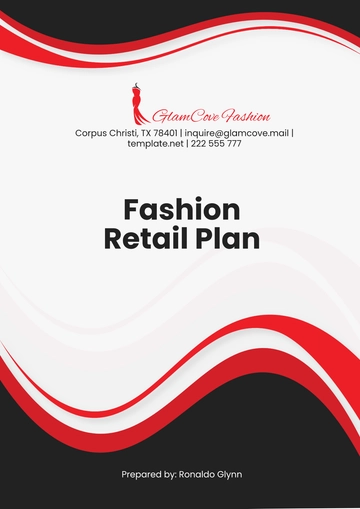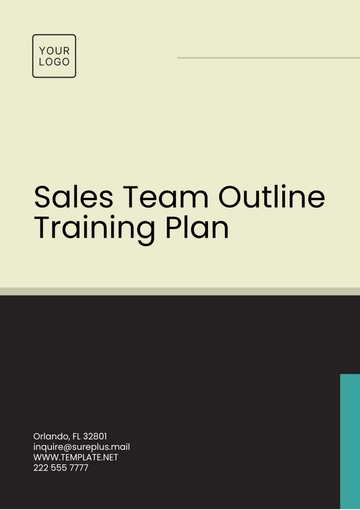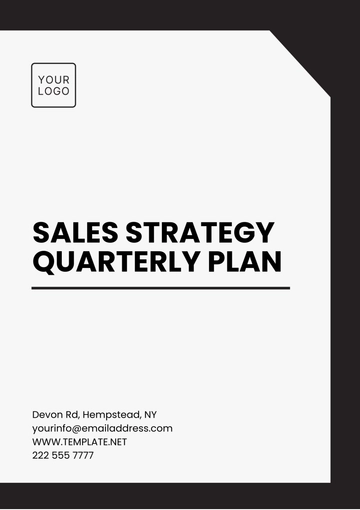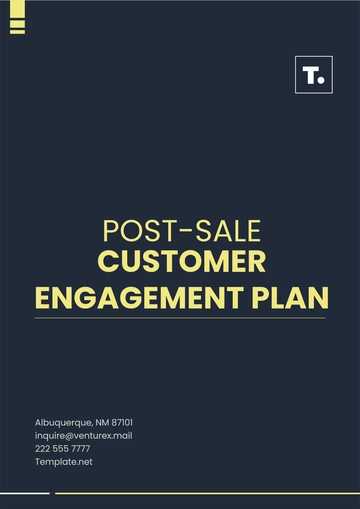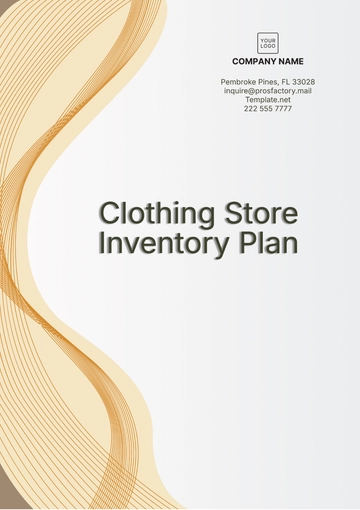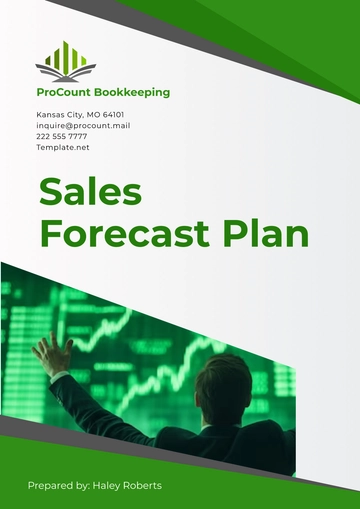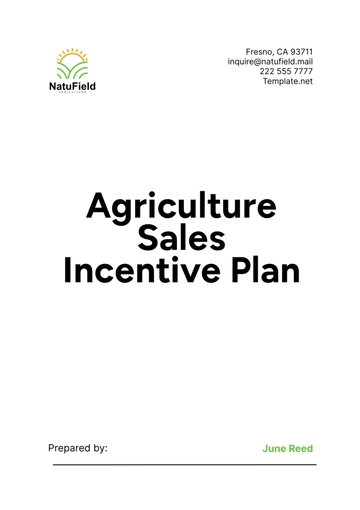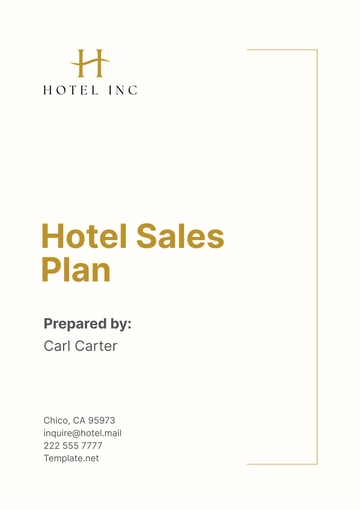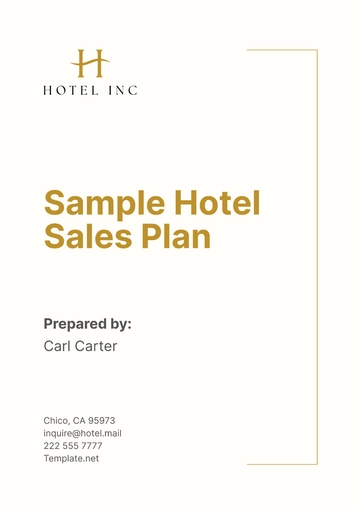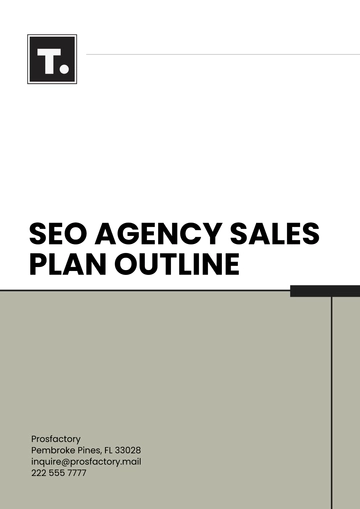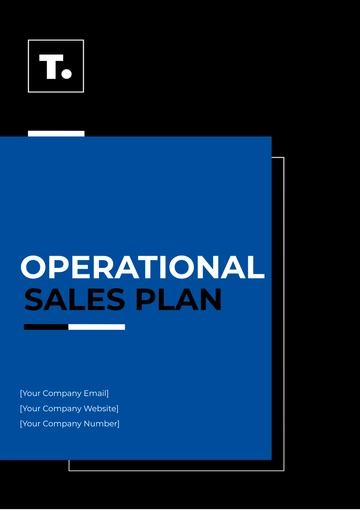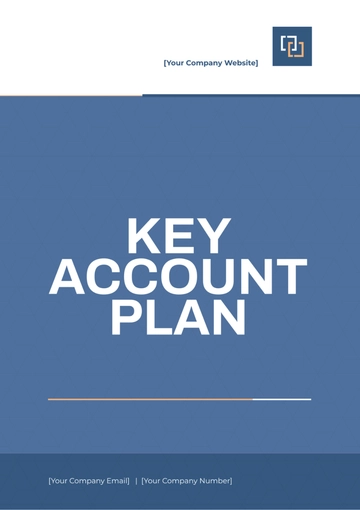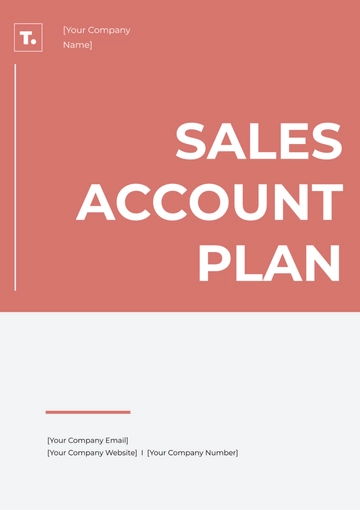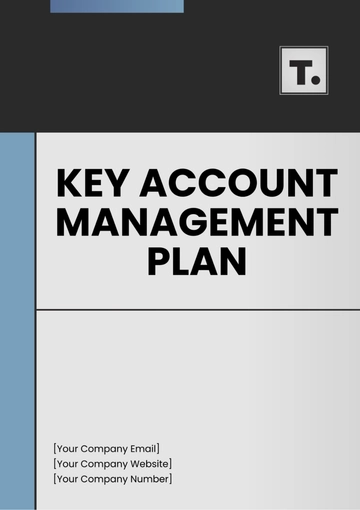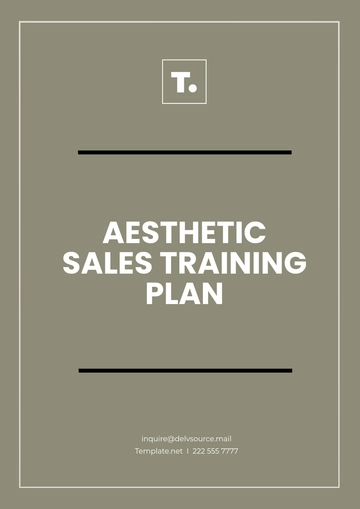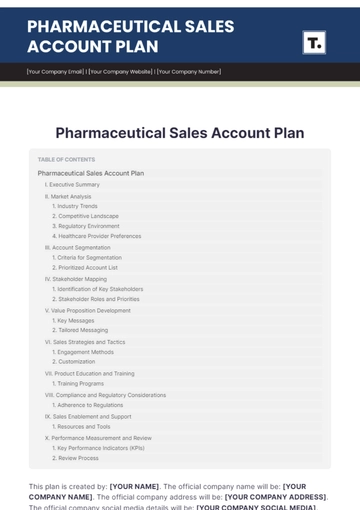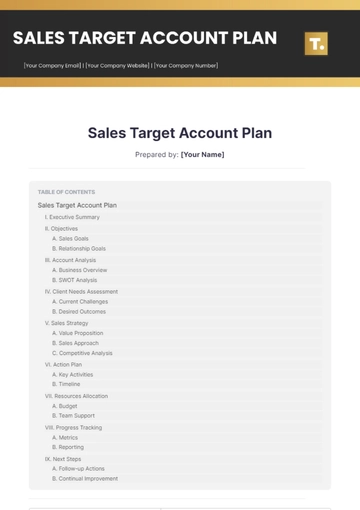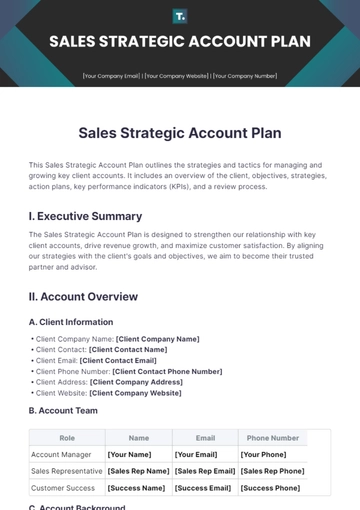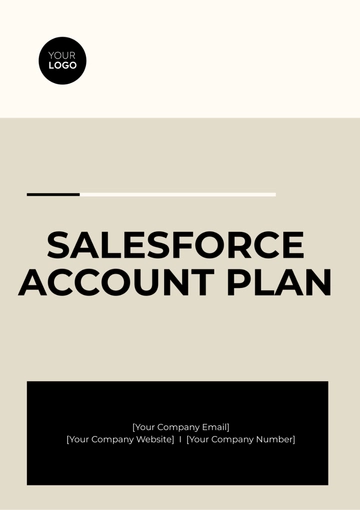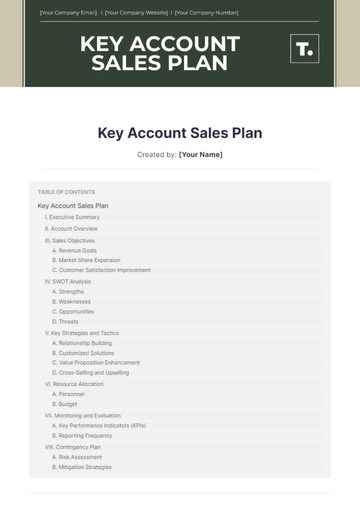Free Sales Customer Experience Improvement Plan
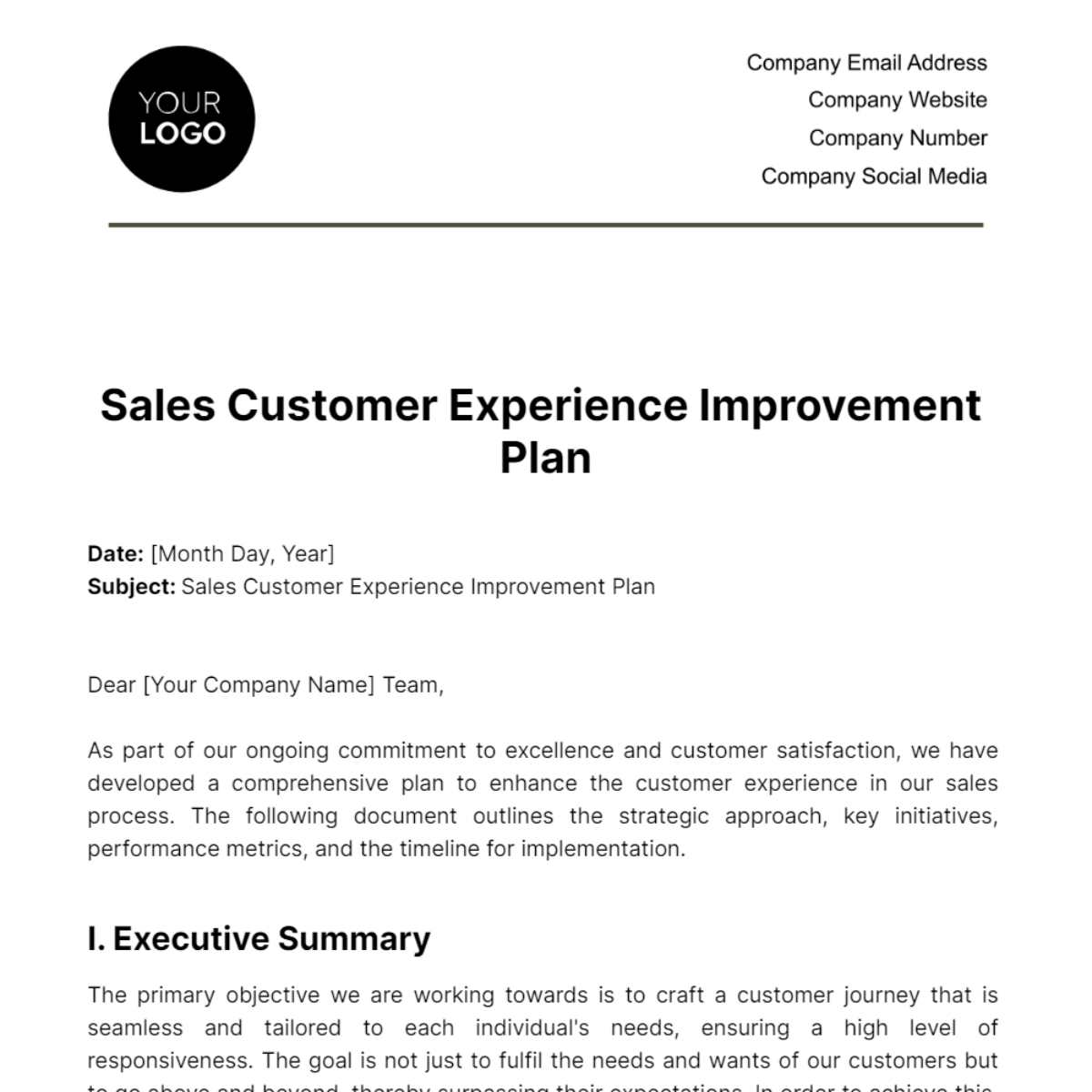
Date: [Month Day, Year]
Subject: Sales Customer Experience Improvement Plan
Dear [Your Company Name] Team,
As part of our ongoing commitment to excellence and customer satisfaction, we have developed a comprehensive plan to enhance the customer experience in our sales process. The following document outlines the strategic approach, key initiatives, performance metrics, and the timeline for implementation.
I. Executive Summary
The primary objective we are working towards is to craft a customer journey that is seamless and tailored to each individual's needs, ensuring a high level of responsiveness. The goal is not just to fulfil the needs and wants of our customers but to go above and beyond, thereby surpassing their expectations. In order to achieve this, we are harnessing the power of customer feedback.
Moreover, we keep ourselves abreast of the industry's best practices and strive to incorporate these benchmarks into our own operations wherever feasible. By doing so, we hope to infuse excellence into our customer interactions and set new standards for customer satisfaction. The end goal behind all these efforts is to ensure that every stage of our customer journey becomes an epitome of quality service and we don't just meet but exceed our customer's expectations.
II. Current State Assessment
In this table, we outlined [Your Company Name]’s current performance metrics across various customer experience aspects and set clear target outcomes to be achieved through the initiatives of our Customer Experience Improvement Plan:
Aspect | Current Performance | Desired Outcome |
Customer Feedback Score | 6.5/10 | 9/10 |
Repeat Customer Rate | 30% | 50% |
Average Response Time | 48 hours | 24 hours |
Sales Conversion Rate | 5% | 10% |
Currently, our customer feedback score stands at 6.5 out of 10. This score reflects the overall satisfaction level reported by our customers. By aiming for a desired outcome of 9 out of 10, we aspire to significantly enhance customer satisfaction. Achieving this target would indicate that our customers consistently find value in our products and services.
Our current repeat customer rate is 30%. This metric measures the percentage of customers who return to make additional purchases. Increasing this rate to the desired 50% signifies stronger customer loyalty and trust. Repeat customers contribute significantly to our revenue and long-term success.
Moreover, our average response time for addressing customer inquiries is 48 hours. Swift responsiveness is crucial for maintaining positive customer interactions. By aiming for an average response time of 24 hours, we commit to providing timely assistance and demonstrating our commitment to customer care.
Our current sales conversion rate stands at 5%. This metric reflects the proportion of leads or prospects who become paying customers. By striving for a 10% conversion rate, we aim to optimize our sales processes and maximize revenue generation.
This data serves as a compass for our improvement journey. It guides us toward achieving excellence in customer experience. By setting ambitious targets, we acknowledge the critical role customer satisfaction plays in our business success. These metrics are not mere numbers; they represent our commitment to delivering exceptional service, fostering loyalty, and driving growth.
III. Customer Experience Initiatives
A. Personalization
Implement CRM Software: By deploying Customer Relationship Management (CRM) software, we can efficiently track customer preferences, purchase history, and interactions. This data enables personalized communication and targeted marketing efforts.
Train Sales Staff: Our sales team should be adept at using customer names and understanding their preferences. Tailoring the sales approach based on individual needs fosters stronger relationships and increases the likelihood of successful conversions.
B. Feedback Loop
Monthly Customer Satisfaction Surveys: Regularly collecting feedback from customers allows us to gauge their experiences, identify pain points, and address any issues promptly. These surveys provide valuable insights for continuous improvement.
Real-Time Feedback Tools on [Your Company Website]: Implementing tools such as live chat or feedback forms directly on our website enables customers to share their thoughts instantly. Quick responses demonstrate our commitment to their satisfaction.
C. Response Time Reduction
Hire Additional Customer Support Staff: Bolstering our support team ensures faster response times. Timely assistance enhances customer trust and loyalty.
Integrate Chatbots: Deploying chatbots for immediate query resolution can significantly reduce response time. These AI-powered assistants handle routine inquiries, freeing up human agents for more complex tasks.
D. Customer Education
Resource Center on [Your Company Website]: Developing a comprehensive resource center with product guides, FAQs, and troubleshooting tips empowers customers. Easy access to information enhances their overall experience.
Monthly Webinars: Hosting regular webinars allows us to educate customers about our products and services. These interactive sessions foster engagement, deepen understanding, and build brand loyalty.
IV. Implementation Timeline and KPIs
A. Implementation Timeline
Here’s the intended timeline for implementing the improvements:
Initiative | Q2 | Q3 | Q4 |
CRM Software | |||
Staff Training | |||
Additional Staff | |||
Chatbot Development | |||
Resource Center |
During Q2, we aim to roll out the CRM software. This tool will empower our sales teams by centralizing customer data, streamlining communication, and enhancing personalization. By tracking preferences and interactions, we can tailor our approach and improve overall customer satisfaction.
In Q2 also, we prioritize training our sales staff. Equipping them with the necessary skills, product knowledge, and communication techniques is crucial. Well-trained sales representatives can confidently engage with customers, address queries promptly, and drive conversions.
In Q3, we plan to hire additional customer support staff. This step directly impacts response time reduction. With a larger team, we can handle inquiries swiftly, ensuring timely assistance and reinforcing our commitment to customer care.
By Q4, we intend to integrate chatbots. These AI-powered assistants will provide immediate query resolution, freeing up human agents for more complex tasks. Chatbots enhance efficiency and contribute to a seamless customer experience.
Simultaneously in Q4, we’ll develop a comprehensive resource center on our website. This hub will house product guides, FAQs, and troubleshooting tips. Empowering customers with self-service options fosters education and satisfaction.
This implementation timeline is not merely a schedule; it’s a roadmap to success. Each initiative aligns with our overarching goal: to optimize sales performance, increase revenue, and enhance customer satisfaction. By executing these steps strategically, we position ourselves for long-term growth and excellence in customer experience.
B. Key Performance Indicators (KPIs)
Customer Satisfaction Index (CSI): Measures overall satisfaction with an organization or specific product/service, shedding light on which aspects meet, exceed, or fall short of customer needs.
Net Promoter Score (NPS): Gauges customer loyalty by asking how likely they are to recommend a product/company to others on a scale of 0-10.
Customer Effort Score (CES): Evaluates the effort customers exert to resolve issues, make requests, or interact with a business.
Sales Conversion Rates: Indicates the percentage of leads or prospects who take desired actions (e.g., making a purchase) based on sales efforts.
Average Response Time: Measures the time taken to respond to customer inquiries or requests.
Repeat Purchase Rate: Reflects the proportion of customers who make multiple purchases, indicating loyalty and satisfaction.
V. Budget Allocation
The following chart and table presents the estimated cost for each initiative:
Initiative | Estimated Cost |
CRM Software | $25,000 |
Staff Training | $15,000 |
Additional Staff | $50,000 |
Chatbot Development | $20,000 |
Resource Center | $10,000 |
Total | $120,000 |
The estimated cost for implementing CRM software is $25,000. This investment aims to centralize customer data, enhance personalization, and streamline communication. By tracking preferences and interactions, we can tailor our approach and improve overall customer satisfaction.
This budget allocation is about strategic investment. Each dollar spent aligns with our overarching goal: to optimize sales performance, increase revenue, and enhance customer satisfaction. By judiciously allocating resources, we pave the way for long-term growth and excellence in customer experience.
Allocating $15,000 for staff training is essential. Well-trained sales representatives can confidently engage with customers, address queries promptly, and drive conversions. This investment ensures that our team is equipped with the necessary skills and knowledge.
The budget of $50,000 for hiring additional customer support staff directly impacts response time reduction. With a larger team, we can handle inquiries swiftly, ensuring timely assistance and reinforcing our commitment to customer care.
Investing $20,000 in chatbot development is strategic. These AI-powered assistants provide immediate query resolution, freeing up human agents for more complex tasks. Chatbots enhance efficiency and contribute to a seamless customer experience.
Allocating $10,000 for developing a comprehensive resource center on our website is crucial. This hub will house product guides, FAQs, and troubleshooting tips, empowering customers with self-service options and enhancing their overall satisfaction.
VI. Monitoring and Reporting
A. Monthly Reports
Regularly generated reports will serve as our compass. These monthly snapshots will track the progress of each initiative. We’ll assess whether we’re hitting our targets, identify bottlenecks, and celebrate wins. Transparency and data-driven insights will guide our decisions.
B. Performance Review
Against each Key Performance Indicator (KPI), we’ll evaluate our performance. Are we inching closer to that desired customer feedback score of 9/10? Is the repeat customer rate climbing toward 50%? These reviews will inform our next steps.
C. Agile Adjustments
Flexibility is key. If an initiative isn’t yielding the expected results, we’ll pivot. Perhaps the chatbot development needs tweaking, or the resource center isn’t resonating with customers. We’ll adjust, recalibrate, and optimize.
Overall, the Sales Customer Experience Improvement Plan is designed to place the customer at the heart of everything we do. Through these strategic initiatives, we will foster a positive customer experience that drives loyalty and growth for [Your Company Name].
We look forward to your support and commitment to making this plan a success.
Best Regards,
[Your Name]
[Your Position]
[Your Email]
[Your Company Name]
- 100% Customizable, free editor
- Access 1 Million+ Templates, photo’s & graphics
- Download or share as a template
- Click and replace photos, graphics, text, backgrounds
- Resize, crop, AI write & more
- Access advanced editor
Improve customer experience with this Sales Customer Experience Improvement Plan Template! This fully editable and customizable plan from Template.net ensures you capture every important detail. The AI Editor Tool makes editing seamless, allowing you to provide a comprehensive plan that enhances your customers’ experience! Never miss out on this resource!
You may also like
- Finance Plan
- Construction Plan
- Sales Plan
- Development Plan
- Career Plan
- Budget Plan
- HR Plan
- Education Plan
- Transition Plan
- Work Plan
- Training Plan
- Communication Plan
- Operation Plan
- Health And Safety Plan
- Strategy Plan
- Professional Development Plan
- Advertising Plan
- Risk Management Plan
- Restaurant Plan
- School Plan
- Nursing Home Patient Care Plan
- Nursing Care Plan
- Plan Event
- Startup Plan
- Social Media Plan
- Staffing Plan
- Annual Plan
- Content Plan
- Payment Plan
- Implementation Plan
- Hotel Plan
- Workout Plan
- Accounting Plan
- Campaign Plan
- Essay Plan
- 30 60 90 Day Plan
- Research Plan
- Recruitment Plan
- 90 Day Plan
- Quarterly Plan
- Emergency Plan
- 5 Year Plan
- Gym Plan
- Personal Plan
- IT and Software Plan
- Treatment Plan
- Real Estate Plan
- Law Firm Plan
- Healthcare Plan
- Improvement Plan
- Media Plan
- 5 Year Business Plan
- Learning Plan
- Marketing Campaign Plan
- Travel Agency Plan
- Cleaning Services Plan
- Interior Design Plan
- Performance Plan
- PR Plan
- Birth Plan
- Life Plan
- SEO Plan
- Disaster Recovery Plan
- Continuity Plan
- Launch Plan
- Legal Plan
- Behavior Plan
- Performance Improvement Plan
- Salon Plan
- Security Plan
- Security Management Plan
- Employee Development Plan
- Quality Plan
- Service Improvement Plan
- Growth Plan
- Incident Response Plan
- Basketball Plan
- Emergency Action Plan
- Product Launch Plan
- Spa Plan
- Employee Training Plan
- Data Analysis Plan
- Employee Action Plan
- Territory Plan
- Audit Plan
- Classroom Plan
- Activity Plan
- Parenting Plan
- Care Plan
- Project Execution Plan
- Exercise Plan
- Internship Plan
- Software Development Plan
- Continuous Improvement Plan
- Leave Plan
- 90 Day Sales Plan
- Advertising Agency Plan
- Employee Transition Plan
- Smart Action Plan
- Workplace Safety Plan
- Behavior Change Plan
- Contingency Plan
- Continuity of Operations Plan
- Health Plan
- Quality Control Plan
- Self Plan
- Sports Development Plan
- Change Management Plan
- Ecommerce Plan
- Personal Financial Plan
- Process Improvement Plan
- 30-60-90 Day Sales Plan
- Crisis Management Plan
- Engagement Plan
- Execution Plan
- Pandemic Plan
- Quality Assurance Plan
- Service Continuity Plan
- Agile Project Plan
- Fundraising Plan
- Job Transition Plan
- Asset Maintenance Plan
- Maintenance Plan
- Software Test Plan
- Staff Training and Development Plan
- 3 Year Plan
- Brand Activation Plan
- Release Plan
- Resource Plan
- Risk Mitigation Plan
- Teacher Plan
- 30 60 90 Day Plan for New Manager
- Food Safety Plan
- Food Truck Plan
- Hiring Plan
- Quality Management Plan
- Wellness Plan
- Behavior Intervention Plan
- Bonus Plan
- Investment Plan
- Maternity Leave Plan
- Pandemic Response Plan
- Succession Planning
- Coaching Plan
- Configuration Management Plan
- Remote Work Plan
- Self Care Plan
- Teaching Plan
- 100-Day Plan
- HACCP Plan
- Student Plan
- Sustainability Plan
- 30 60 90 Day Plan for Interview
- Access Plan
- Site Specific Safety Plan

